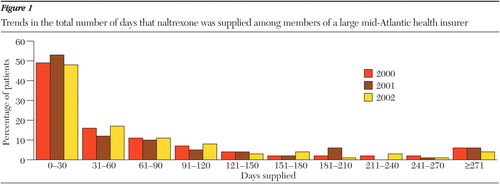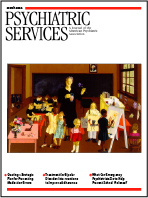Datapoints: Trends in Naltrexone Use Among Members of a Large Private Health Plan
Naltrexone was approved by the Food and Drug Administration in 1994 as an adjunct to psychosocial therapy for alcohol-dependent and alcohol-abusing patients. Clinical evidence suggests that when naltrexone is combined with psychosocial treatment models, it reduces the percentage of days that the patient drinks, reduces the alcohol consumed when the patient does drink, and prevents the patient from relapsing and drinking excessively and destructively (1). Guidelines recommend that patients use naltrexone daily for three to six months and up to 24 months on the basis of the patient's preference and compliance with treatment (1).
Despite evidence of naltrexone's effectiveness (1), use rates remain very low. Naltrexone is prescribed for less than 13 percent of patients who are undergoing treatment for alcohol dependence and abuse (2) and is prescribed regularly by less than 15 percent of addiction specialists (3).
To determine how the rate and duration of naltrexone use have changed over time, we analyzed paid claims for patients of a large mid-Atlantic health insurer with more than three million members who were taking naltrexone among the subpopulation of 1.5 million members who were 18 years or older and had prescription drug and behavioral health benefits provided through the health plan. We calculated the number of filled naltrexone prescriptions per 10,000 members and the total number of days that naltrexone was supplied per patient from 2000 to 2002.
Our data confirmed the low use rates and revealed no clinically meaningful trend toward increasing naltrexone use over time. Our data suggest that less than 10 percent of plan members who received alcohol treatment in any setting received naltrexone in any of the three study years.
Our data also suggest that a typical patient who initiates naltrexone treatment uses the medication for a substantially shorter period than the recommended guidelines and that trends in the duration of naltrexone use have not changed over time (Figure 1).
Existing research suggests that a lack of information, physicians' perceptions that naltrexone is ineffective, and a lack of marketing by the manufacturer help to explain the low rates of naltrexone use (2,3).
Dr. Harris is affiliated with the office of applied studies of the Substance Abuse and Mental Health Services Administration, 5600 Fishers Lane, Room 16-105, Rockville, Maryland 20857 (e-mail, [email protected]). Dr. DeVries and Mr. Dimidjian are with Highmark Blue Shield in Pittsburgh. Harold Alan Pincus, M.D., and Terri L. Tanielian, M.A., are editors of this column.

Figure 1. Trends in the total number of days that naltrexone was supplied among members of a large mid-Atlantic health insurer
1. Naltrexone and Alcoholism Treatment. Treatment Improvement Protocol no 28. Rockville, Md, US Department of Health and Human Services, Public Health Service, Substance Abuse and Mental Health Services Administration, Center for Substance Abuse Treatment, 1998Google Scholar
2. Mark TL, Kranzler HR, Song X: Understanding US addiction physicians' low rate of naltrexone prescription. Drug and Alcohol Dependence 71:219–228, 2003Crossref, Medline, Google Scholar
3. Thomas CP, Wallack SS, Lee S, et al: Research to practice: adoption of naltrexone in alcoholism treatment. Journal of Substance Abuse Treatment 24:1–11, 2003Crossref, Medline, Google Scholar



